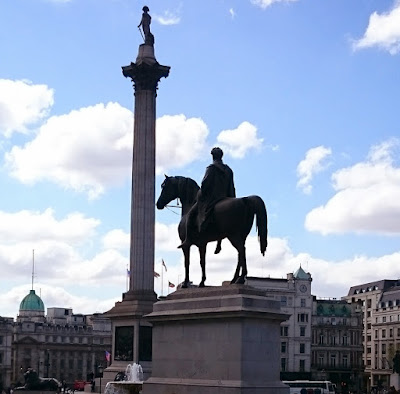 |
| Trafalgar Square, London |
Although I live down by the sea in sunny Weymouth in Dorset, I am fortunate to have the opportunity to visit London on a regular basis as my parents live a short train journey away from the capital. Walking through the streets of London, I always try to spot things with a Georgian connection and my husband, Andrew, obligingly takes lots of photos for me.
This post takes a look at some of the statues in London that commemorate Georgian royalty and other prominent figures. It is by no means an exhaustive list and no doubt I will discover more in the future.
This post takes a look at some of the statues in London that commemorate Georgian royalty and other prominent figures. It is by no means an exhaustive list and no doubt I will discover more in the future.
George III and George IV
Let us start with royalty. There are impressive equestrian statues in London of both George III (1738-1820) and George IV (1762-1830) situated within a short distance of each other. George III, by the sculptor Matthew Cotes Wyatt, is on Cockspur Street—a two minute walk away from Sir Francis Legatt Chantrey’s statue in Trafalgar Square, where George IV sits astride his horse in front of the National Gallery.
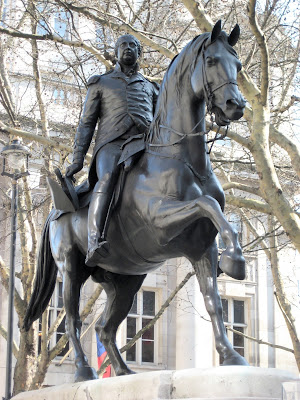 |
| Equestrian statue of George III, Cockspur Street, London |
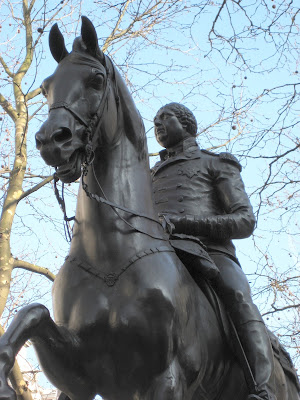 |
| Equestrian statue of George III, Cockspur Street, London |
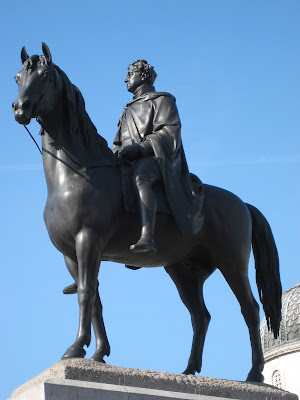 |
| Equestrian statue of George IV, Trafalgar Square, London |
 |
| Detail from equestrian statue of George IV, Trafalgar Square, London |
At the top of his column in Trafalgar Square is the famous naval hero of the Battle of Trafalgar, Admiral Horatio Lord Nelson (1758-1805). But perhaps lesser known is the Duke of York column, just off The Mall, supporting a statue of Frederick, Duke of York (1763-1827), George III’s second son, who was Commander in Chief of the British Army 1795-1809 and 1811-1827.
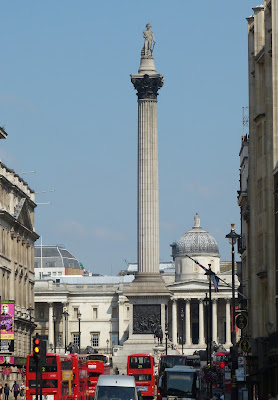 |
| Nelson's Column, Trafalgar Square, London |
 |
| Statue of Admiral Horatio Lord Nelson on Nelson's Column, Trafalgar Square, London |
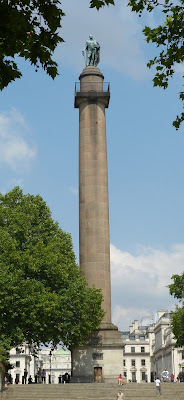 |
| Duke of York Column, The Mall, London |
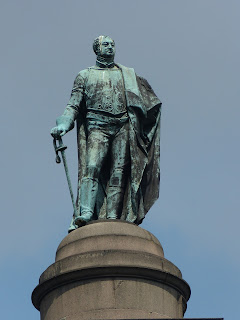 |
| Statue of Frederick, Duke of York, on Duke of York Column, The Mall, London |
Appropriately, there is a statue of Sir Joshua Reynolds (1723-1792), the first President of the Royal Academy, in the courtyard of Burlington House on Piccadilly, home to the Royal Academy since 1874.
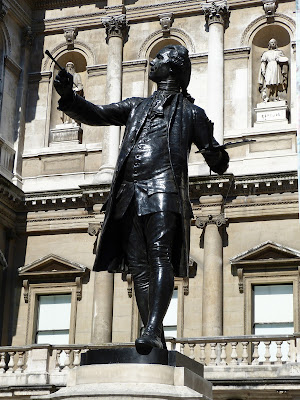 |
| Statue of Sir Joshua Reynolds, Burlington House, Piccadilly, London |
On the outside of the Royal Society of Painters in Watercolours on Piccadilly, you can see the busts of famous artists including JMW Turner (1775-1851) and Paul Sandby (1731-1809), one of the founder members of the Royal Academy.
 |
| Bust of JMW Turner, Piccadilly, London |
 |
| Bust of Paul Sandby, Piccadilly, London |
In 1956, a bust of the architect John Nash (1752-1835) was erected outside All Souls Langham Place—a church that he had designed.
The statue of Beau Brummell (1778-1840) on Jermyn Street is relatively new—it was only erected in 2002. It seems a fitting site for Beau—looking down the Piccadilly Arcade with its superior shops selling everything for the gentleman of fashion, from made-to-measure suits and footwear to jewellery and grooming products.
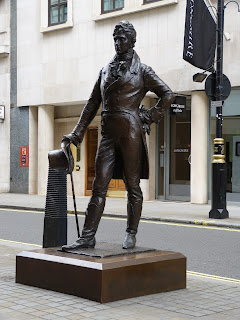 |
| Statue of Beau Brummell, Jermyn Street, London |
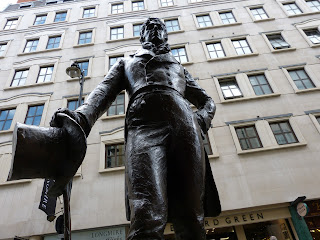 |
| Statue of Beau Brummell, Jermyn Street, London |
 |
| Statue of Beau Brummell, Jermyn Street, London |
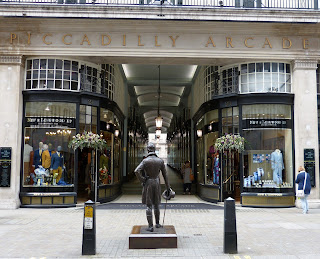 |
| Statue of Beau Brummell, Jermyn Street, London |
 |
| Statue of Beau Brummell, Jermyn Street, London |
The famous Romantic poet, Lord Byron (1788-1824), is commemorated by a somewhat isolated statue in a very unromantic position on a traffic island on the hugely busy Park Lane.
Adam Smith (1723-1790) was a Scottish economist and philosopher. He wrote The Wealth of Nations in 1776—it was still on the reading list when I studied economics at university! You can find his statue on the rear of Burlington House.
 |
| Statue of Adam Smith, Burlington House, Piccadilly, London |
Captain James Cook (1728-1779) was a naval captain, explorer and cartographer. His statue was erected on The Mall in 1914.
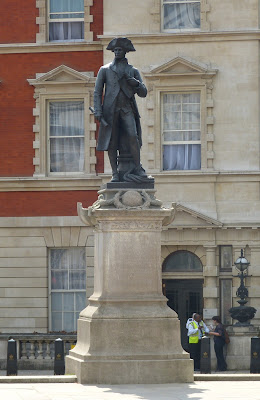 |
| Statue of Captain James Cook, The Mall, London |
An equestrian statue of Arthur Wellesley, 1st Duke of Wellington (1769-1852), military hero of the Battle of Waterloo and British Prime Minister stands on Threadneedle Street, outside the Bank of England.
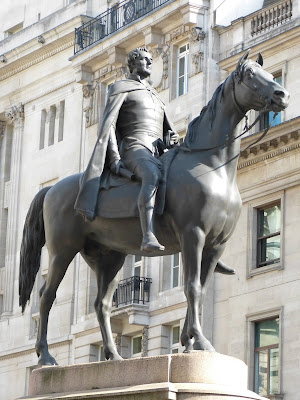 |
| Equestrian statue of 1st Duke of Wellington, Threadneedle Street, London |
 |
| Equestrian statue of 1st Duke of Wellington, Threadneedle Street, London |
Another Georgian Prime Minister, George Canning (1770-1827), stands in Parliament Square along with several of his successors, including Sir Robert Peel (1788-1850).
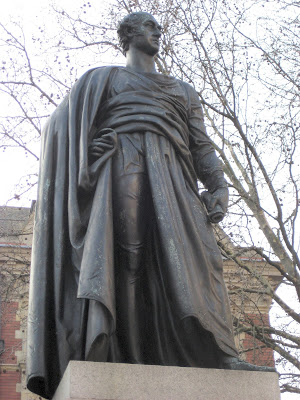 |
| George Canning, Parliament Square, London |
 |
| Sir Robert Peel, Parliament Square, London |
A statue of the Whig politician Charles James Fox (1749-1806) stands in Bloomsbury Square Gardens. He holds a copy of the Magna Carta in his hand, signifying his role as the 'Man of the People'.
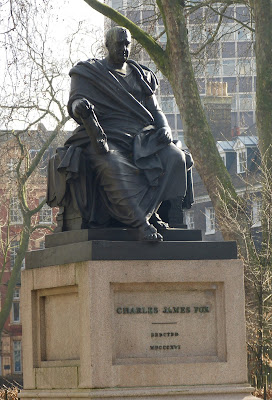 |
| Statue of Charles James Fox, Bloomsbury Square, London |
Thomas Coram (1668-1751) set up the Foundling Hospital in 1741. His statue is outside the Foundling Museum on Brunswick Square, London.
 |
| Statue of Thomas Coram, Brunswick Square, London |
John Wesley (1703-1791) was an evangelical Anglican minister who, together with his brother Charles and George Whitefield, founded the Methodist movement. His statue stands in the gardens of St Paul’s Cathedral.
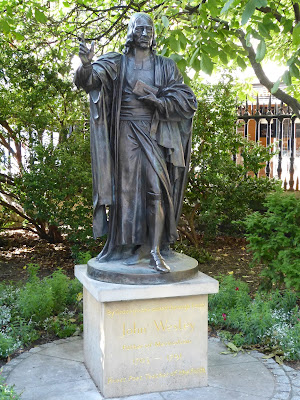 |
| Statue of John Wesley, outside St Paul's Cathedral, London |
Rachel Knowles writes clean/Christian Regency era romance and historical non-fiction. She has been sharing her research on this blog since 2011. Rachel lives in the beautiful Georgian seaside town of Weymouth, Dorset, on the south coast of England, with her husband, Andrew.
Find out more about Rachel's books and sign up for her newsletter here.If you have enjoyed this blog and want to encourage me and help me to keep making my research freely available, please buy me a virtual cup of coffee by clicking the button below.
All photographs © RegencyHistory.net

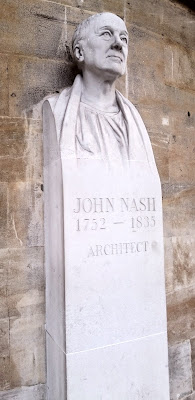
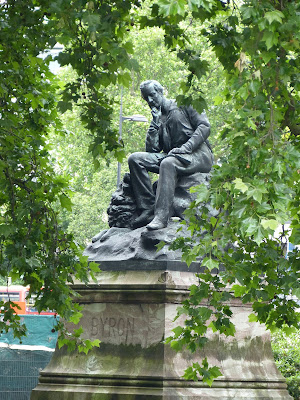

No comments:
New comments are not allowed.